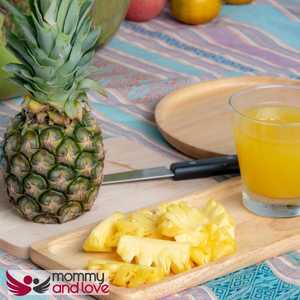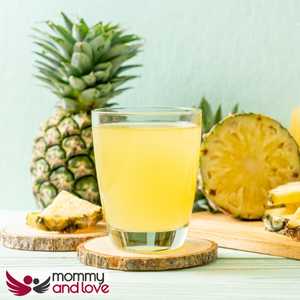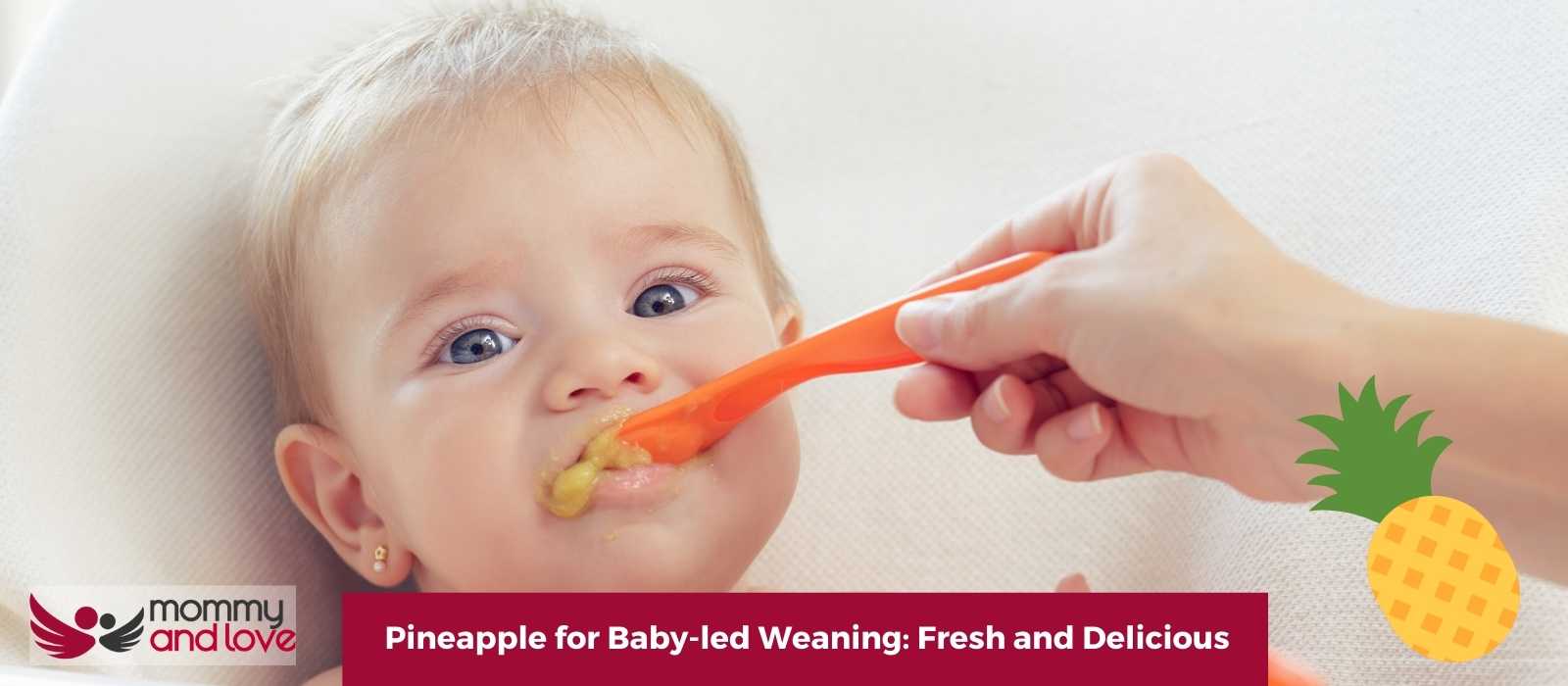Introducing pineapple into your baby’s ever-expanding diet is a great way to start them on the path to healthy eating. Not only is it fresh and delicious, but pineapple also has some amazing health benefits. Babies who are introduced to solid foods through self-feeding often enjoy trying new fruits and vegetables, and pineapple is a perfect starter food!
In this blog post, we will discuss the nutritional value of pineapple, as well as some recipes that you can use to introduce your baby to this amazing fruit.
What Are the Health Benefits of Pineapple?

Pineapple is not only a delicious and refreshing fruit, but it also contains many nutrients that are beneficial for a baby.
This nutritious tropical fruit is an excellent source of Vitamin C, which helps to boost the immune system and supports the development of healthy bones and teeth.
Additionally, pineapple contains bromelain, an enzyme that aids in digestion and helps to reduce inflammation.
Pineapple is also a good source of dietary fiber, which helps to keep the digestive system functioning properly. Fiber can also help people feel fuller for longer, which may reduce the number of calories people consume throughout the day.
When choosing pineapple for a 6-month-old baby, be sure to select a ripe fruit; unripe pineapple can be excessively tart and may cause the baby’s stomach pain.
When Can Babies Eat Pineapple?
The American Academy of Pediatrics revised its solid food guidelines in 2012, which now recommend that babies older than 6 months can eat most foods without restriction.
However, there are some guidelines you need to follow especially when introducing acidic fruits due to their citric acid content.
So, when can your baby eat pineapple? Most babies can start eating pineapple at around 6 months old. Make sure the fruit is prepared safely and because pineapple is a soft fruit that is easy to chew and swallow.
Which Pineapples to Give to Babies
However, it is important to make sure that the pineapple is ripe and free from any bruising or blemishes. You may also want to cut the pineapple into small pieces to reduce the risk of choking.
Raw pineapple is a healthy and delicious treat that most babies will enjoy. For parents who are looking for new ideas, there are many recipes that use pineapple as an ingredient, such as smoothies, purees, and even baby food recipes.
So go ahead and introduce your little one to this tropical fruit today just make sure you make pineapple safe before giving it to your child.
Remember to always introduce only one new food at a time and watch out for an allergic reaction every time you introduce new foods, especially when giving citrus fruits like oranges. Such foods can cause a wide range of reactions.
Can Babies Choke on Pineapple?
Pineapple is a popular fruit that is enjoyed by people of all ages. However, pineapple can pose a choking hazard for babies. The small, hard seeds of pineapple can get lodged in a baby’s throat, and the sharp edges of the pineapple flesh can also cause irritation.
For this reason, it is important to cut the pineapple into small pieces and remove the seeds before giving it to a baby.
Pineapples should also be given to babies under supervision, and they should be kept away from pineapple skins and stems, which can also be a choking hazard. With a little care, pineapple can be a safe and enjoyable tasty fruit for babies to enjoy.
Can Babies Be Allergic to Pineapple?
Pineapple is a popular juicy fruit that is enjoyed by people of all ages. However, some people may be allergic to pineapple especially those with oral allergy syndrome. Symptoms of food allergies can include an itchy mouth or throat, hives, and difficulty breathing after your child eats pineapple.
If you suspect that you or your child has allergic reactions to pineapple, it is important to seek immediate medical attention and talk to your baby’s pediatrician for advice.
An allergic reaction to pineapple can be serious, so it is important to get the diagnosis and treatment that you need. Also, cross-reaction to both pollen and other fruits is possible especially if you have a family history.
Diaper rash from pineapples has been known to occur and was reported after some babies eat pineapples, so keep this in mind.
Can Babies Drink Pineapple Juice?

Please do not give your baby pineapple juice. Most juices have a lot of added sugar and babies under 12 months old should not drink juice. Juice should be completely cut off from your baby’s diet.
The American Academy of Pediatrics recommends that parents limit the intake of juice for babies under two years of age as fruit juices do not offer them any nutritional benefits.
If your baby is old enough, pineapple juices can be a great source of vitamins and it can help boost their immune system. It’s also a good source of fiber, which can help keep their digestive system healthy. Just be sure to dilute the pineapple juices with water before giving it to your baby, and make sure they don’t drink too much.
Too much juice can cause your baby to become overweight or even develop type 2 diabetes.
How Much Pineapple Can a Toddler Have?
A toddler can have a few tablespoons of fresh pineapple, such as one slice. Too much pineapple can give a toddler diarrhea. so it is best to give a toddler just a little bit at a time.
How to Make Pineapple Puree
Pureed pineapple is a delicious and easy-to-make addition to any dish. You can use either fresh or canned pineapple ring. If you decide to use canned pineapple, make sure to rinse it first to remove excess sugar.
To make a puree, start by peeling and slicing the pineapple. Then, place the slices or pineapple chunks in a blender or food processor and blend until smooth. If needed, add a little water or coconut milk to help the blending process.
You can store excess puree in an ice cube tray or airtight container. Enjoy your fresh pureed pineapple on its own or use it in your favorite recipes.
What to Mix Pineapple Puree With for Baby Food?
There are a few different ways to mix pineapple puree with other foods for baby food. One way is to mix it with plain yogurt to make a sweet and tangy dip or sauce. Another option is to mix it with oatmeal to create a creamy breakfast cereal. You could also add pureed pineapple to your child’s favorite smoothie recipe for a delicious and healthy snack.
If you want to make a fruit salad, you can add mango, papaya, and banana to the fresh or frozen pineapple. If you want to serve it alone, start with 2 parts pineapple to 1 part water and adjust from there until you get the consistency that is right for your baby.
No matter how you choose to mix it, your baby is sure to love the sweet and tangy flavor of pineapple!
How Do You Prepare Pineapple for Babies With Baby-Led Weaning
Preparing pineapple is simple. Babies who are starting to wean can enjoy pineapple as a healthy and tasty snack. There are two ways to prepare pineapple for babies who are doing baby-led weaning: thin strips or finely chopped.
You can cut the top off of the pineapple, then cut it in half lengthwise. Cut off the skin and remove the core. Then, cut into strips or serve finely chopped.
Both methods are simple and easy to do and your baby will love the sweet and tangy taste of pineapple.
How to Choose and Store Pineapple as Baby Food
Pineapple is a great fruit to introduce to your baby as it is sweet and nutritious. You don’t need to buy organic pineapple but when choosing a pineapple, look for one that is thin-skinned with bright green leaves. The pineapple should also have a sweet smell. Avoid pineapples with bruises or brown spots.
To store the pineapple, place it in the fridge in a plastic bag. It will keep for up to four days. You can also freeze the pineapple by chopping it into thin strips or finely chopping it. It will keep in the freezer for up to six months.
Simple Pineapple Recipes for Babies
Pineapple as an ingredient is easy to make and fun to eat. These recipes will give your baby a healthy, nutritious treat that is also delicious and makes serving pineapple easy. You can even get them involved in the process from start to finish.
One savory dish you can make with pineapple is a simple stir-fry. All you need is some cubed pineapple, diced onion, and minced garlic. Cook them over medium heat in a tablespoon of olive oil until the onions are translucent.
This makes a great side dish or light main course.
Ripe pineapple is also a versatile fruit that can be used in both sweet and savory dishes. For a sweet dish, try pureeing some pineapple with breast milk to make a healthy smoothie. Or you could bake a pineapple upside-down cake for a special treat.
Conclusion on Can Babies Have Pineapple
Introducing your baby to pineapple is a great food for babies who are starting solid foods compared to other acidic fruits. Offering pineapple is a good idea because it is considered a healthy fruit. And babies love its sweet and tangy taste. It is also a good source of vitamins and minerals, including vitamin C and manganese.
There are many different ways to prepare pineapple for babies, so you can find the perfect recipe for your child.

This article was written by Sandra Baker – full time writer and the mother of four amazing kids (including twins!)
She’s also a breastfeeding counselor and has spent years helping new parents learn how to care for their children. When she’s not writing or caring for her children, Sandra likes to spend time reading and taking walks with her husband.




